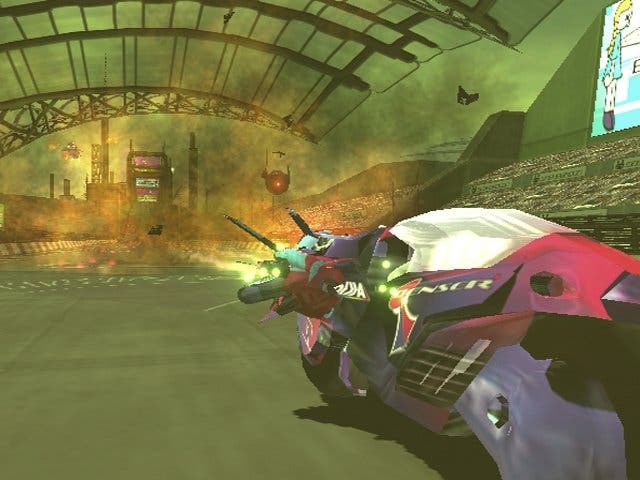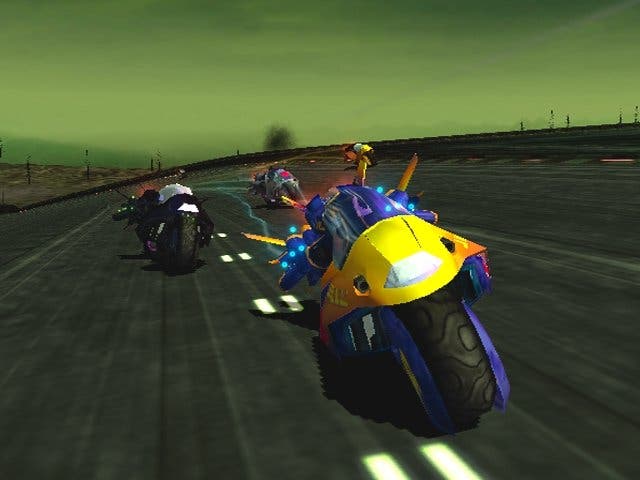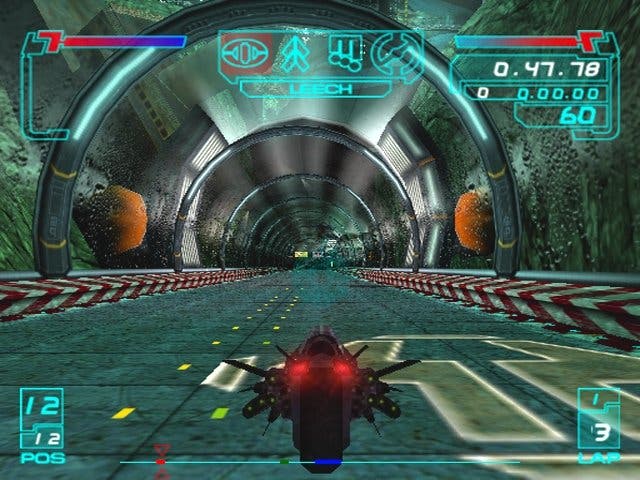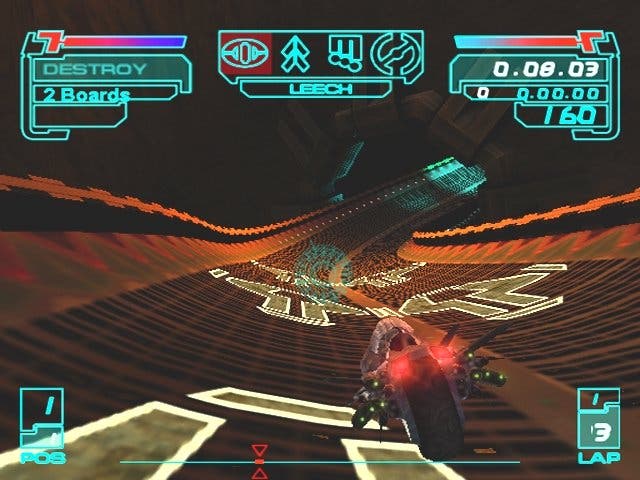XGRA
The definitive futuristic racer, or just XGRA-ment?
Extreme G Racing has always chugged along rather nicely carving its own two wheeled version of events in 'the future', despite living in the long shadow cast by the WipeOut series and, of course, F-Zero. Amusingly, the press blurb talk of a future motor sport "unlike anything ever experienced". What, absolutely nothing like its rivals in any way? We'd better look into these outlandish claims.
It's instantly obvious this is the usual hopeful press release nonsense, but after several hours in the company of XGRA it certainly has enough going for it to deserve further investigation from fans of the genre, even if it harbours precisely zero innovation.
Half The World Away

So what's the story? Once again, the SiNN (Sports Interactive News Network) has branched out from making football management simulations and teamed up with the XGRA (Extreme-G Racing Association) to create the ultimate motor sport of the future, set in the Solar System's most inhospitable regions.
You wonder how far game developers can go with outlandish improbability, but in the future anything is possible, so we get to tear around at upwards of 800mph, navigating a space station on top of an asteroid orbiting Jupiter, on the sea bed of the Southern Indian Ocean, a canyon on Mars, the Amazon basin, an unpolluted city and various other equally stunning (and utterly implausible) locations.
As with just about any racing game ever, the three main modes are covered, so you get Career, Arcade and Time Attack. In career mode the game plays out pretty much how it did in the largely ignored Extreme G3, which tasks rookies with having to meet a points target in order to progress to the next race class.
Supersonic

Kicking off with Invitation class, the challenge is to impress the watching sponsors, who will hire you to drive for their team should you come through the three races with enough points. Thereafter it's a straight slog through Subsonic, Sonic and Supersonic, with each class subdivided into several rounds, normally comprising three or four races. Finishing as high up the rankings as possible is your overall goal, and wins you the points you need to qualify for the next class, but each race also tasks you with completing a 'contract' which could involve beating a nominated opponent, beating three drivers, destroying opposing teams' sponsorship hoardings, setting a fastest lap/race time, or killing a set number of opponents.
The destruction element is nothing new, but the power up system has been given an overhaul, allowing players the flexibility of selecting which weapon or temporary power up they want. At the lowest end of the scale, collecting one power up token gives a rather limp secondary weapon, but if you carry on picking up tokens you can access more useful upgrades, like shields, extra acceleration, or, better still, invincibility. You can even unleash a devastatingly destructive blast that takes out your opponent altogether.
Unlike the previous Extreme G3, your shield recharges automatically, so rather than find yourself utterly knackered; you can tactically ease off the gas and avoid being dumped out of the race. Likewise, the presence of numerous boost pads all over the track means gaining extra speed is down to your driving rather than the use of a limited rechargeable boost.
We like Blur too

Without a doubt, XGRA is one of the speediest games you'll ever play, or ever want to play. On the frequent occasions where you top 800 mph, the whole screen blurs into warp speed, making it practically impossible to steer or see where you're going. It's a nice graphical effect, make no mistake, but hardly helpful when you're constantly battering your ship from left to right and back again.
The intense speed is XGRA's biggest problem - it's just too damned fast for its own good, and isn't aided by some less than forgiving handling. We thought this initially might be something that would improve as we upgraded our ship. Indeed, once you qualify for the next class, you can choose to race for other teams; some of which may have better ships. Each ship has a rating out of five for its handling, acceleration, shield, regeneration and speed, so we eventually plumped for the bike with the best handling. Sure, it made a noticeable difference, but you're still left flapping around the track haplessly with no real sense of control over what you're doing.
The track design is also completely crackers, and after a few hours of doing corkscrews and loop the loops we felt like we'd been stuck in a washing machine on spin cycle. It certainly all looks lovely, with some beautifully rendered environments, detailed opponents with glowing coloured vapour trails, and some great explosive effects, but frankly your eyes will freak out keeping up with it all. And we should probably point out that there are an insane number of multiple routes as well, as if we weren't confused enough.
Roll with it

Another problem we had was the general opponent AI. With seven opponents on the track to race against, you'd expect to be able to outwit at least some of them from the word go, but what tended to happen, with puzzling regularity, was that the first lap or so would see the CPU streak ahead, leaving us in eighth place, and then we'd gradually be let back into the race until we eventually finished somewhere on the podium. Only on the hardest, Supersonic class were we even remotely in danger of not qualifying despite the odd slip up (for example on a Mars track so laden with smoke that it's practically impossible to see where you're going).
Equally puzzling was the fact that it seemed to matter little whether you fulfilled the contract objectives or not. Sometimes we'd manage to do what it asked, sometimes not, but it made little difference to whether we qualified at the end of it all.
And yet at its best, XGRA can be mightily entertaining. Collecting enough power up tokens to unleash a death blast is immensely satisfying, but in our experience it was pointless even attempting to use the default primary weapon, the useless cannon, or whatever your chosen rider has equipped as standard. Even some of the supposedly better power-up weapons were fairly ineffective, making the combat element somewhat more of a chore than it should be.
D'ya wanna be a Spaceman?
Elsewhere, the fairly functional Arcade and Time Attack modes do exactly what you'd expect, although rely on you playing Career mode before you can make much use of the 16 tracks on offer. Multiplayer is limited to two player on the PS2, but offers a multitude of modes; Normal, Endurance, Extreme Weather, Peace Keeper, and Speed Limited - all fairly similar, except one might have gun turrets placed on it to shoot, or you might be devoid of weapons/power-ups. We prefer to have weapons - it all feels a big lightweight without them.
Doesn't make for pretty reading overall, does it? Were it not for the cretinous handling that leaves you bouncing all over the track, and dumb AI that usually lets you off the hook anyway, we might have really liked XGRA. As it stands, though, we blitzed through the game in a few hours, and frankly have no compulsion to go back to it. If you really warm to futuristic racers then you'll doubtlessly get something out of it. But be warned, it won't prove a major challenge, and you'll probably wish you could play F-Zero GX (not long now) or even the criminally ignored Quantum Redshift instead. Not XGRA-ment, then, but certainly a bit whiffy.

